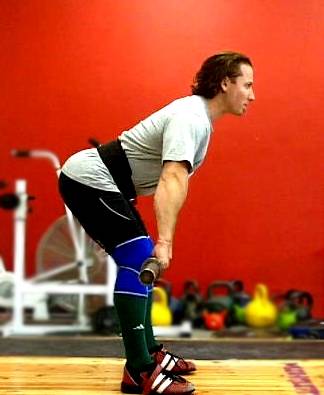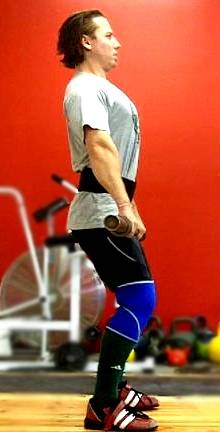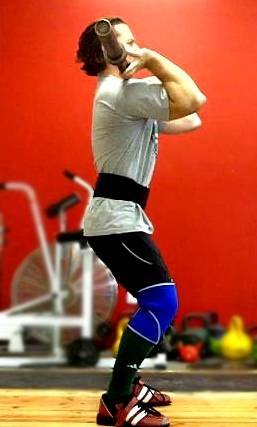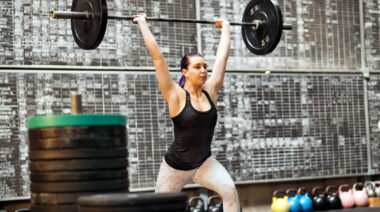Photo by Bev Childress
There’s propaganda floating around that the hang clean is so crazy-complicated that you probably shouldn’t bother with it at all. Many coaches will avoid teaching it, for this reason, leaving literally hundreds of thousands of athletes in this country underpowered as a result.
Don’t believe the hype. Hang cleans are hard, but they ain’t THAT hard. Anyone can learn to do a decent hang clean – anyone. And what’s better is that you only need to know three steps to do it!
I used to have a lot of fun messing around with computer animation programs. In those programs, you can quickly create a moving image by only drawing two or three frames. In animation, they call these “key frames.” You tell the computer the most important positions you want your character to be in during your “movie” and the program will do the work of drawing all the intermediate steps for you.
Below, I’m going to give you the three “key-frames” of the hang clean – well, a hang power clean if we’re being technical – because the way to learn anything quickly, no matter how complicated, is to hone in on its key structural elements – its skeletal structure. Your body will fill in the rest without you having to think too hard about it.
If you can do that – learn the three keyframes of a proper hang clean – and then simply practice moving smoothly between them, you’ll be on your way to lifting more weight and building a stronger and more powerful body in the process. Conversely, if you DON’T hit these positions during your lift, you are leaving a lot of weight off the bar.
Step One: The Knee Position

You want to start the bar literally touching your knee-caps. Your weight is on your heels. And, you should have your hips up high enough so that your knee angle is very shallow. This is going to cause a lot of hamstring stretch! In fact, I like to tell people that if this position feels comfortable, you’re probably doing it wrong – or, you’re a yoga master.
Your shoulders will naturally be forward over the bar. That’s a good thing. However, this presents a problem: the bar will want to drift away from you and no longer touch the knee-caps. The way to solve this is to squeeze your lats as tight as you can. The lats act as an arm “depressor” – the pull the arms into your body. Use that to your advantage here. The lats need to be as tight as humanly possible.
Key Points to Remember:
- Weight on your heels.
- Hips high like a yoga master.
- Lats tight – squeeze the bar into you.
Step Two: The Hip Position

The hip position is the most important position in weightlifting. If you can drill this spot and make it the most comfortable place in the world for you to be, then you will end up being very good at any variation of the Olympic lifts – including the hang clean. If not, you won’t. It’s that simple.
The bar should be touching your body as high up your thigh as possible. Again, your weight should be on your heels.
The shoulders will now be backward BEHIND the bar. That fact is important. You want to make sure that before you jump that bar above your head, your shoulders have gotten back behind the bar.
Why?
Because if you don’t, then the bar will have a more horizontal trajectory coming into the hip rather than the vertical trajectory that you want. That horizontal bar path will cause the bar to bounce off of your hip forward, then swing around you. With heavy weights, you’ll miss it.
Instead, get your shoulders back (mimic the photo), THEN jump the bar up.
Key Points to Remember:
- Weight on the heels.
- Shoulders back behind the bar.
- Lats tight.
Step Three: The Catch

Now for the easy part. Catching a power clean is really not very complicated. All you do is catch it in the EXACT same position you’d be in if you were a quarter of the way down in a front squat.
Your heels should be taking most of your weight. Your elbows are high and in. (If you were looking at yourself in a mirror, your elbows would be pointing right at you.) And your legs and hips look just like they would look if you were doing a quarter squat (a quarter of the way down).
Key Points to Remember:
Weight on the heels.
Elbows high and IN,
Legs and hips in a quarter squat.
Putting It All Together
Obviously, there is more to doing a hang clean than just three steps. But, these are the three most important steps – the skeletal structure – that you MUST learn and make the hang clean totally subconscious.
The first mistake people make with the clean is that they try to move too fast too early. Be patient! The bar MUST move from the knee position to the hip position deliberately. If you DON’T end up at the hip position during your pull then you have wasted the lift.
The bar starts out slow and ends up fast. It is accelerating NOT exploding from the knee. Yes, you must end up going at maximum speed when the bar is at the hip. But, you should not start at maximum speed from the knee. I would err on the side of going slower than you are comfortable with to start out. Hitting the right spots is far more important in the beginning than going fast and using lots of weight with hideous form.
- Start at the knee,
- Accelerate to the hip (touch it!) and explode the bar up.
- Then all you have to do is catch it.
How simple is that?! Obviously, you’ll need to practice. But, now you know the only three things that you should focus on. Drill each of these positions, drill your ability to move from one to the other smoothly, and over time you’ll be able to add speed, and eventually weight to the bar.
Give that a try and then come back and leave your comments below telling me about how it went. I want to hear from you!






